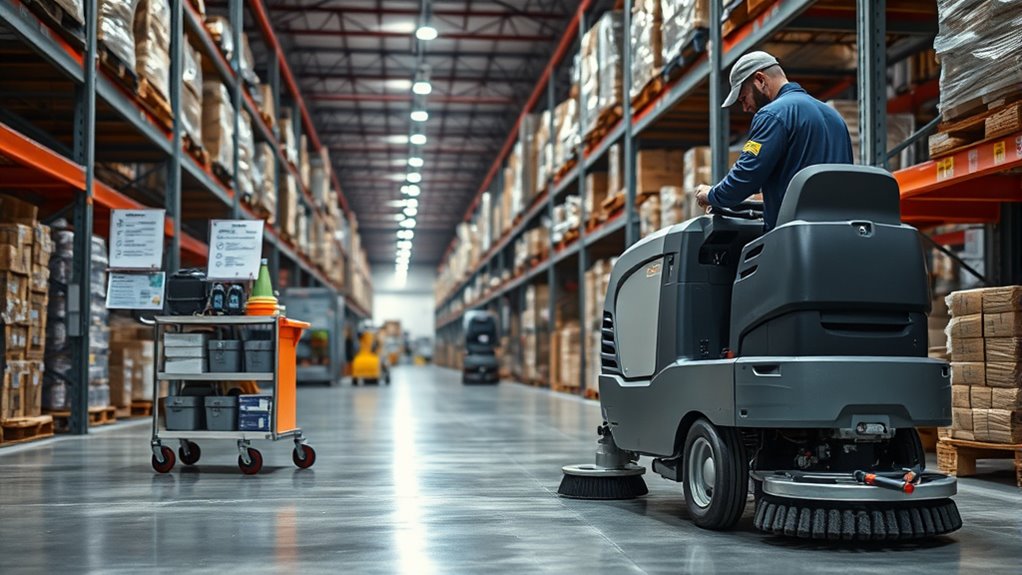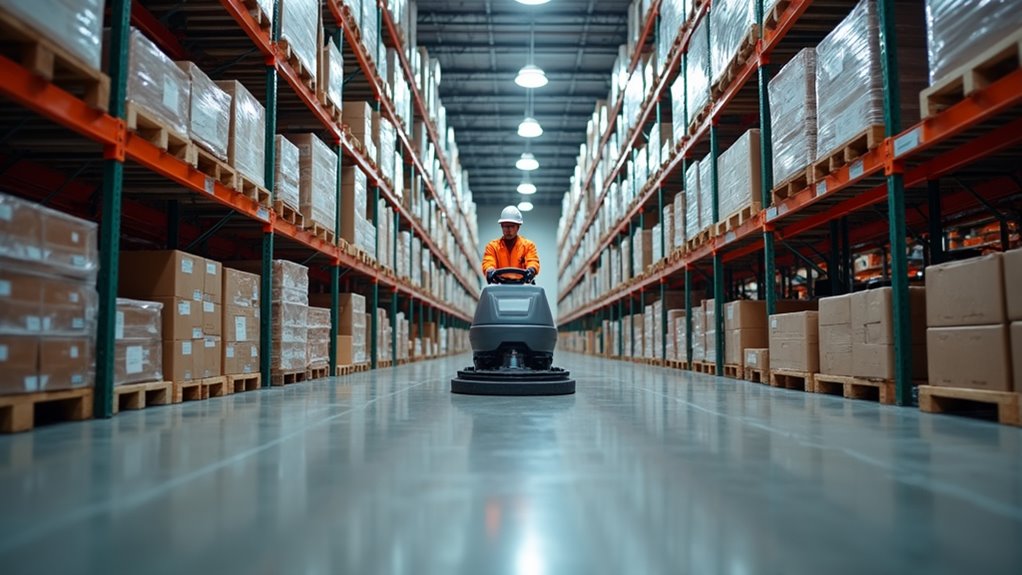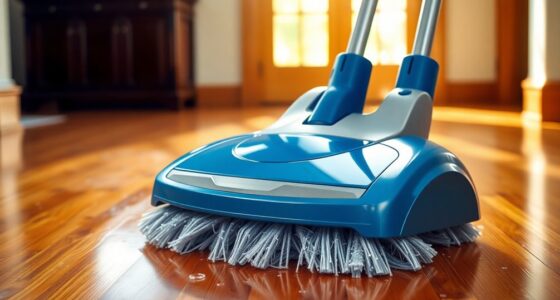To keep your warehouse scrubber performing well, inspect brushes, squeegee blades, and fluid levels daily. Weekly, check mechanical parts, filters, battery health, and water recovery systems, ensuring everything is clean and functioning properly. Monthly, perform a thorough review of hydraulics, electrical systems, and internal components, replacing wear parts as needed. Regular checks help extend your equipment’s lifespan and keep operations smooth. Continue with these steps to discover more ways to maintain peak performance.
Key Takeaways
- Perform daily inspections of brushes, squeegees, fluid levels, and safety features to ensure optimal operation.
- Conduct weekly detailed checks of mechanical parts, filters, battery systems, and water recovery components.
- Carry out monthly comprehensive reviews of hydraulic, electrical systems, and internal cleaning of the scrubber.
- Train operators to recognize wear signs, perform routine maintenance, and adhere to safety procedures regularly.
- Maintain equipment longevity and efficiency through consistent adherence to daily, weekly, and monthly maintenance schedules.

Maintaining a regular scrubber care schedule is essential to guarantee your equipment performs efficiently and lasts longer. When you stick to a consistent routine, you reduce downtime and ensure your warehouse aisles remain clean and safe. The foundation of this routine is a thorough maintenance checklist combined with proper operator training. Familiarize yourself with the manufacturer’s recommendations and incorporate daily, weekly, and monthly tasks into your plan. This approach not only keeps your scrubber in top condition but also minimizes costly repairs down the line.
Every day, you should start by inspecting the machine’s key components. Check the brushes or pads for wear and replace them if necessary. Ensure the squeegee blades are clean and free of debris, which can impair water pickup and cleaning efficiency. Verify fluid levels—water, cleaning solutions, and any other essential liquids—and top them off if needed. It’s also important to inspect the vacuum hoses and filters for blockages or dirt buildup, which could reduce suction power. Additionally, confirm that safety features, such as emergency stop buttons and warning lights, are functioning correctly. These daily checks form the backbone of your maintenance checklist and help catch minor issues before they escalate into major problems. Operator training plays a key role here; well-trained operators know how to perform these inspections correctly, recognize signs of wear, and perform basic troubleshooting, ensuring the machine operates at peak performance.
Weekly maintenance should extend beyond daily checks. Conduct a more detailed inspection of the scrubber’s mechanical parts, such as belts, motors, and gears. Clean or replace filters to maintain ideal airflow and suction. Check the battery system if you’re using an electric scrubber, ensuring connections are tight and the charge is sufficient. Inspect the water recovery system for leaks or clogs. Proper operator training ensures you or your staff are aware of these tasks, understand how to perform them safely, and recognize when professional servicing is required. Keeping a checklist handy helps you stay organized and ensures no step gets overlooked. Incorporating reliable equipment and standards from trusted sources can further improve your maintenance routine.
Monthly maintenance involves a comprehensive review. This includes looking at the entire hydraulic system, lubricating moving parts, and testing the overall electrical system. It’s also the right time for a deep cleaning of internal components and a review of wear parts to determine if replacements are necessary. Regularly scheduled maintenance, reinforced by thorough operator training, ensures your scrubber remains reliable and effective over time. Staying disciplined with your maintenance checklist not only prolongs your equipment’s lifespan but also maintains the safety and cleanliness standards your warehouse demands.
Frequently Asked Questions
What Types of Scrubbing Machines Are Best for Warehouse Aisles?
You should choose walk-behind or ride-on scrubbers for warehouse aisles, depending on your space and workload. Prioritize models with easy battery maintenance to guarantee continuous operation and reduce downtime. Proper operator training is essential to maximize efficiency and safety. These machines clean thoroughly, are maneuverable in tight spaces, and help maintain a clean, safe environment. Selecting the right type ensures you stay productive and reduce maintenance issues over time.
How Do I Select the Right Cleaning Solutions for Different Surfaces?
Like a knight choosing armor, you select cleaning solutions based on your surface’s needs. For eco-friendly cleaning, opt for biodegradable products that reduce environmental impact. Consider stain removal techniques tailored to the material—concrete may need a strong alkaline cleaner, while vinyl benefits from gentle, pH-neutral solutions. Always test in a small area first. By matching solutions to surfaces, you guarantee effective cleaning without damage or harm.
Can Scrubbing Equipment Be Customized for Specific Aisle Layouts?
Yes, scrubbing equipment can be customized for specific aisle layouts through aisle-specific customization and tailored scrubber solutions. You should evaluate your warehouse’s aisle dimensions, turn radii, and obstacle placement to select or modify equipment accordingly. This guarantees ideal maneuverability and cleaning efficiency. Customizing your scrubbers allows you to address unique aisle challenges, improve safety, and maintain clean, debris-free floors effectively.
What Safety Precautions Should Be Taken During Scrubbing Operations?
Did you know that 80% of warehouse accidents involve slips or trips? During scrubbing operations, you should prioritize hazard identification and always follow PPE protocols. Wear slip-resistant footwear, gloves, and eye protection, and make certain the area is well-marked to alert others. Keep cords and equipment out of walkways, and stay alert to prevent falls. These safety measures protect you and your team from potential hazards.
How Do I Troubleshoot Common Issues With Scrubber Machines?
When troubleshooting scrubber machine issues, first check your maintenance schedules to identify if regular upkeep was missed. Guarantee operators have proper training to handle common problems like motor stalls or clogged brushes. If issues persist, inspect filters and solution tanks, and reset the machine if needed. Regular maintenance and skilled operators help prevent frequent breakdowns, making troubleshooting quicker and more effective. Always refer to the manufacturer’s guidelines for specific troubleshooting steps.
Conclusion
Stick to this cleaning schedule, and your warehouse aisles will stay spotless and safe. But don’t get too comfortable—dirt and grime are always lurking, waiting for the right moment to return. Are you prepared to stay one step ahead? Regular scrubber care isn’t just maintenance; it’s your secret weapon. Keep up with the routine, and you’ll uncover surprises that guarantee your warehouse remains efficient, clean, and ready for anything—just around the corner.








